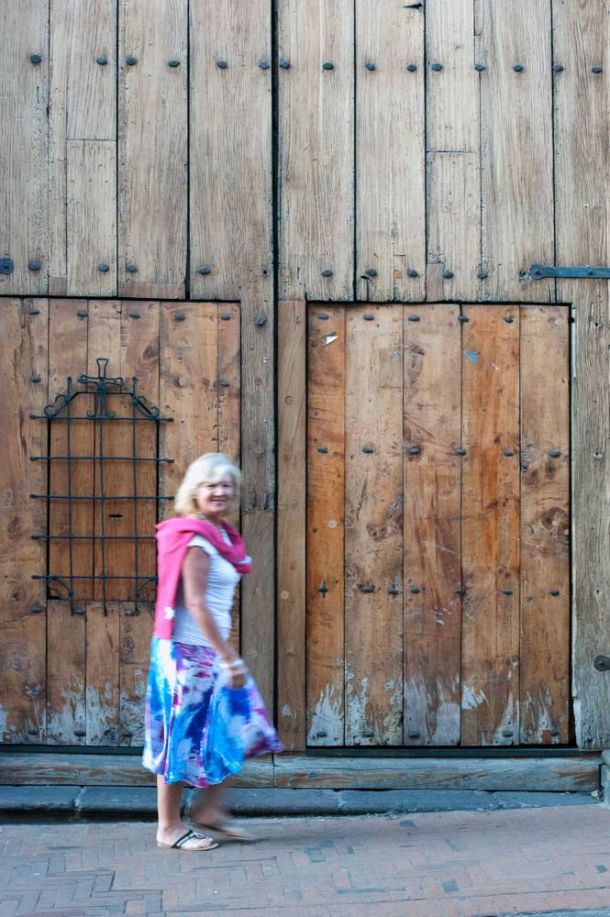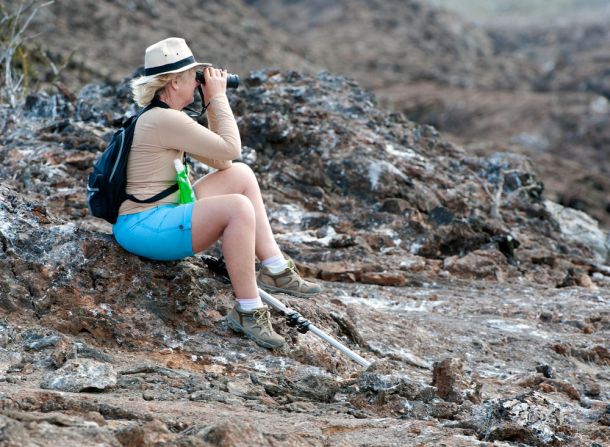As with most travel it’s down to comfort and common sense. Be aware of the environment you’re going into and how you like to feel generally.
If you’re travelling to Ecuador, the Cloud Forest, Amazonia and Galapagos as we did then you’re going to need a fair selection of alternatives – as well as your ‘little black number’ for the evenings!
You’ll find that most in the forests wear safari colours (khaki, beige, stone) & materials (cottons and breathables), partly to fit in with the environment, mainly because it’s the most practical as you’ll be trekking in the forest, sitting in a canoe or wading ashore and its only in the evenings when you might want something smart casual to relax in.
I think the whole point of travel clothing is simply loose comfort and being at one with your environment. Avoid white as its too stark in the forests and shows every mark and give a miss to dark colours (black and blue in particular) as they attract biting insects.
My suggestion is to take along some long sleeves and light jumpers for the early morning and evenings even though you’ll probably be hot and sticky in the daytime – although it can be quite chilly with cloud cover and wind.
As you might know, I’m unfortunate in that every insect known to mankind bites me; whereas as nothing bites Geoff when I’m around. That said, if you’re like me, it’s useful to have long sleeves for dawn and dusk as this is when the bugs are most active. If you’re sensitive to sun then you’ll need plenty of protection anyway and its best to be wise about this as even amidst the forest cover there will still be times when you’re exposed to the sun.
Geoff and I seem to buy hats each time we travel as we prefer to buy cheaper department store hats that will squash flat, breath but absorb perspiration, ideally have a neck strap to keep them on our heads and wash easily. When we’ve bought super hats we’ve been more precious about them than necessary as they’re difficult to transport without damage and don’t seem to fare any better in terms of performance. It’s easier to throw away a cheapy if washing doesn’t resurrect it than part with a treasured fedora.
I like to take a couple of simple accessories such as a sarong and/or light scarf that can either wrap around my face as protection from the sun around my neck and shoulders – or over my knees and legs if in shorts. Geoff’s taken to doing the same, especially if we’re in boats and canoes as the back of the neck is quite vulnerable and you can easily suffer from heat stroke if you’re not careful.
The chances are that you might get caught in rain or the middle of a cloud, so simply prepare for this with a light rain jacket. Sensible shoes (for walking) and two pairs of sandals (one for chilling and the others waterproof for beach/reef walking) are all that’s necessary and although I prefer a choice and a change, many people seem to be happy with the newer hybrid breathable waterproof trainers that cope with walking and wet landings in the Galapagos.
I’ve put together my suggested packing list and split it into two – safari Ecuador and General. It’s not exhaustive as you’ll have certain personal preferences but you should use it as a minimum. You can’t always guarantee to get laundry done when you want it (the Galapagos ships are quite good at this however) so you might need to pack to allow for the three different environments you’ll find yourself in – city, forest, and marine.
Apart from the obvious this list applies to both male and female.
ECUADOR (inc. Galapagos)
Clothes:
- Pairs of casual trousers and a couple of pairs of shorts
- At least one light cotton dress and clothes for hotel and evenings over dinner
- 4 or 5 long-sleeve shirts
- 4 or 5 short sleeve or T-shirts
- A jumper
- A warm, showerproof jacket
- A pair of walking shoes
- Two pairs of sandals (casual and waterproof for canoe/beach)
- Night-wear?
- Swimwear – wet suits are provided, as are snorkels, flippers and masks unless you want to take your own. A one-piece suit is easier to deal with to avoid a malfunction when dragging wetsuits on and off!
- A hat with wide brim and retaining cord
- Sarong, shawl or cloth wrap for neck, shoulders, legs.
- Your normal selection of underwear
Kit:
There are not many additional items that you wouldn’t already take on any normal holiday. For the most part your guides will keep you away from harm, in vehicles and boats that are fit for purpose and you’ll be eating food that’s as good as you’d get anywhere. If you relax and apply simple common sense then you shouldn’t have a problem and won’t need to take a pharmacy and hardware store with you. In our experience we only ever had problems with people who did things in the jungle that they wouldn’t dream of doing at home – such as the lady who left all her diabetes medication behind because ‘she wanted a holiday away from it all.’ She got one as she was out of it for some time! Anyway…
- Camera – whatever you’re comfortable with – I’d certainly take an underwater one if possible (or see Geoff’s list for more serious snappers).
- Chargers, data cards and spare batteries.
- Binoculars
- Plug adaptors. Power is 110 volts with generally American style three pin plugs on both mainland and Galapagos ships
- Water bottle – useful for when ashore or in the forests..
- Waterproof bag – for camera kit/binoculars in canoes/zodiacs or for dirty/wet linen
- Sunblock and after-sun/moisturiser
- Lip balm
- Mosquito/bug repellent and Anthisan
- Malaria tablets
- Multi-purpose knife eg. Leatherman with knife, scissors, tweezers, screwdriver etc (don’t pack it in hand luggage)
- Sunglasses with polarized lenses
- Books/e-readers for reading during leisure time
- Books on birds & wildlife – although you will find them in the lodges and on board
- A journal to record the wildlife you see and people you meet – unless you don’t mind loads of pictures of nameless beings.
General:
- Money belt
- Alarm – although most camps wake you with tea/coffee
- Mini sewing kit – although I don’t think we’ve ever used it
- Deck of cards – we always take them to while away the odd hour
- Personal toiletries
- Wet wipes/hand sanitizer – most gippy tummies are self-inflicted by hand to mouth contact
- Sanitary and/or birth control requirements
- Personal medication
- Reading glasses – contact lenses are not always good because of the dust – but if you do bring them then bring spares and solution
- Painkillers
- Allergy remedies
- Motion/sea sickness tablets
- Antiseptic cream, anti-histamine creams
- Basic 1st Aid kit for minor cuts and abrasions.
The bare necessities:
- Pen, pad and Calculator
- Passport – valid for at least 6 months with appropriate visas
- Visa – given to us by ground agents
- Yellow fever certificate (if coming from ‘at risk’ country)
- Phone numbers for Ground Agents contacts etc.
- Two extra passport photos, two photocopies of your passport, visa and travel tickets to carry separately from your travel documents
- An additional form of photo I.D. g. driving license
- Air tickets & vouchers
- Travel insurance
- Emergency phone number and contact details
- Credit cards, traveller checks and/or cash in currencies
- Vaccination certificates (if required)
- Medical history and prescriptions
- Phone number of your driver/ car park at home
- Home keys for when you return

 Let us plan your own inspiring journey to Ecuador and throughout Central & S. America
Let us plan your own inspiring journey to Ecuador and throughout Central & S. AmericaWhy not download the TLC World guide brochure or give us a call today on 01202 030443, or simply click ‘enquire’ to submit your own personal itinerary request









